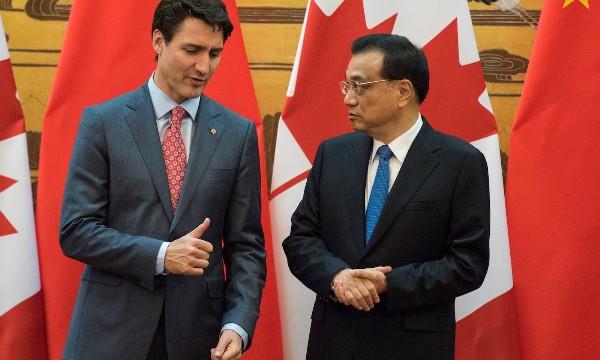
Canada's future Pacific presence not aimed against China
'Important regional issues' were addressed by Canadian Prime Minister during his five-day visit to China, which wrapped up on Thursday. The hotly disputed East and South China seas, where Beijing is locked in territorial rows with a number of neighbors, were likely part of the discussion between the two countries, even if in their official statements there is no reference to them.
While the competition for building the is heating up, and a US-sponsored bloc against China appears to be taking shape in the Indo-Pacific arena, Beijing could be monitoring how the Canada will position itself at a time of growing Sino-US naval rivalry.
Must-reads from across Asia - directly to your inboxLast June, the People's Liberation Army Navy gave the Royal Canadian Navy (RCN) a taste of what treatment regional and non-regional navies usually receive from Beijing in East Asian waters. At the time, Canadian frigate HMCS Winnipeg by Chinese warships while conducting freedom-of-navigation exercises with US, Japanese and Australian vessels in the South China Sea. The encounter came as the Canadian ship was carrying out a five-month deployment – codenamed Poseidon Cutlass 17 – in the region.
Developing a blue water navyNew combat vessels will crowd the Pacific Rim in the future, with some of them waving the Maple Leaf flag. Canada is a Pacific actor and its prosperity depends on international trade. That means Ottawa has an interest in keeping sea routes free and secure on its western flank. To contribute to maritime security, the Canadian government plans to develop a blue-water navy capable of projecting power far from national shores.
Similarly to New Zealand, Canada seems more inclined to make political and economic overtures to the Chinese government. Within the Anglosphere in the Pacific, Australia is the only country ready to side with the US, Japan and India to counter Beijing's military rise
Canada's frigate program is worth C$62 billion (US$49 billion) and should be completed in two decades. Though its naval buildup is backed up by a solid economic growth, Ottawa will fail to meet Washington's expectations that all members of the Northern Atlantic Treaty Organization raise defense spending to 2% of the gross domestic product.
Canada will buy 15 surface warships to replace the RCN's existing frigates and retired destroyers. Currently, the Canadian Pacific Fleet comprises 15 ships and submarines, while its Atlantic twin has 18 vessels in service.
According to its , the Canadian government aims to maintain a routine presence in the Pacific. It recognizes that not only North Korea's nuclear and missile activities but also territorial disputes threaten regional stability. Ottawa says it wants to be a reliable player in the area and contribute to its security. To achieve this goal, it will conduct more naval operations and exercises with allies and partners such as the United States, Australia and New Zealand.
Balancing approachBut Canada is keen to develop stronger relations with China as well. No wonder the Poseidon Cutlass 17 saw the RCN . Ottawa is trying to remain a neutral force in East Asia. Similarly to , it seems more inclined to make political and economic overtures to the Chinese government. Within the Anglosphere in the Pacific, is the only country ready to side with the US, Japan and India to counter Beijing's military rise.
Canada is working to conclude a free-trade agreement with the Chinese giant, even though Trudeau pointed out during his China trip that any possible final deal with Beijing would have to . China is Canada's largest trading partner after the United States. Canadian exports to the Asian powerhouse stood at C$21 billion in 2016.
Ottawa is attempting to diversify commercial partners while it is renegotiating the North American Free Trade Agreement with Washington. This effort gained momentum after US President Donald Trump's decision to abandon the Trans-Pacific Partnership on free trade on the first day of his tenure.
Other regional prioritiesTrade with China is not the only factor influencing Canada's Pacific strategy. There is also a problem of distribution of forces. Given that its naval potential will remain limited even after the new frigates' deployment, Ottawa has to take into account its regional priorities other than the Pacific Ocean. The RCN has to work with its NATO counterparts against Russia's naval resurgence in the Atlantic space. And it has to defend Canada's Arctic waters, which are becoming more crowded as the melting ice is opening new polar shipping routes.
All that said, as Beijing is not perceived as a rival in Ottawa, it is doubtful that the Trudeau administration will ever join formal or informal alliances against the Chinese dragon. Rather, it is likely that new Canadian frigates will keep at a safe distance from hot spots in East Asia in case of a crisis between China and the United States. In the foreseeable future, their presence there will be confined to freedom-of-passage operations under the watchful eye of Chinese warships.
Asia Times is not responsible for the opinions, facts or any media content presented by contributors. In case of abuse, .
Legal Disclaimer:
MENAFN provides the
information “as is” without warranty of any kind. We do not accept
any responsibility or liability for the accuracy, content, images,
videos, licenses, completeness, legality, or reliability of the information
contained in this article. If you have any complaints or copyright
issues related to this article, kindly contact the provider above.

















Comments
No comment